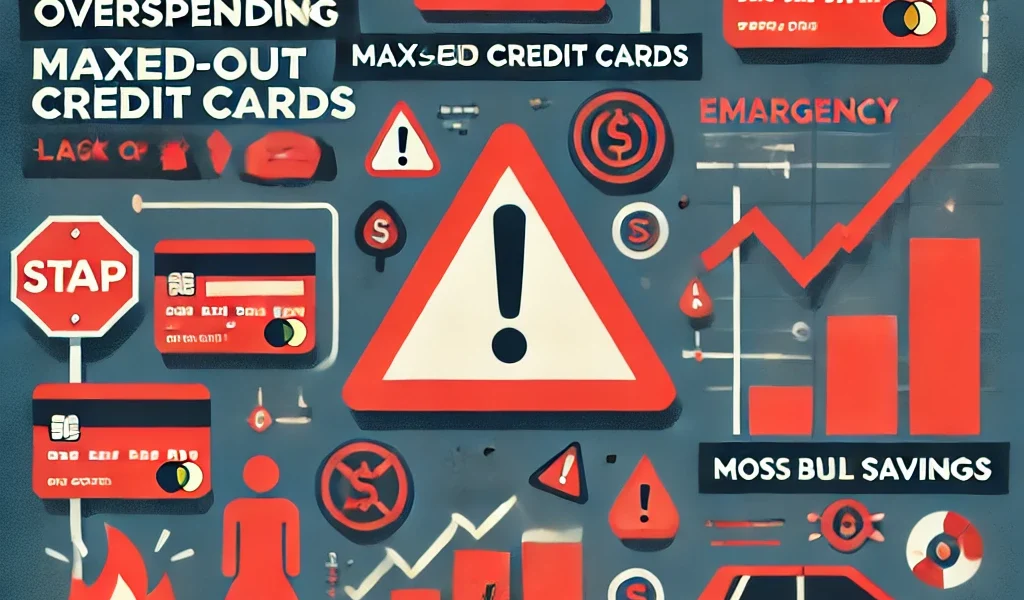Introduction
Managing personal finances can be challenging, but ignoring financial warning signs can lead to long-term money problems. Whether you’re living paycheck to paycheck, struggling with debt, or failing to save for the future, recognizing financial red flags early can help you take control of your financial well-being.
In this blog, we’ll explore key financial red flags that indicate you need a better money plan and offer practical solutions to get your finances back on track.
1. Living Paycheck to Paycheck
Why It’s a Red Flag:
If you find yourself running out of money before your next paycheck, it’s a sign that your expenses are too high or your income is too low. This leaves no room for savings and makes you vulnerable to financial emergencies.
How to Fix It:
- Create a Budget: Track your income and expenses to identify unnecessary spending.
- Cut Costs: Reduce expenses on non-essentials like dining out and subscriptions.
- Increase Income: Consider side gigs, freelance work, or asking for a raise.
2. Carrying High-Interest Debt
Why It’s a Red Flag:
Debt, especially credit card debt, can quickly spiral out of control due to high interest rates. If you’re only making minimum payments, your debt will continue growing.
How to Fix It:
- Pay More Than the Minimum: Focus on paying off high-interest debts first.
- Use the Snowball or Avalanche Method: Choose a repayment strategy that suits your financial situation.
- Consolidate Debt: Look into balance transfer credit cards or personal loans with lower interest rates.
3. No Emergency Fund
Why It’s a Red Flag:
Unexpected expenses like medical bills or car repairs can throw your finances off balance if you don’t have a safety net.
How to Fix It:
- Set a Savings Goal: Aim for at least 3-6 months’ worth of living expenses.
- Automate Savings: Set up an automatic transfer to a high-yield savings account.
- Cut Back Temporarily: Reduce discretionary spending to build your fund faster.
4. No Retirement Savings
Why It’s a Red Flag:
If you’re not saving for retirement, you risk financial insecurity later in life. The earlier you start, the more you benefit from compound interest.
How to Fix It:
- Enroll in a 401(k) or IRA: Contribute enough to get any employer match if available.
- Increase Contributions Over Time: Even small increases can have a big impact.
- Consider Low-Cost Index Funds: These offer steady growth with minimal fees.
5. Overspending with Credit Cards
Why It’s a Red Flag:
Using credit cards for everyday expenses and not paying the full balance each month can lead to accumulating debt.
How to Fix It:
- Use Cash or Debit: Stick to spending only what you can afford.
- Track Credit Card Spending: Limit usage to planned purchases.
- Pay Off Balances Monthly: Avoid carrying a balance to prevent interest charges.
6. Ignoring Financial Statements
Why It’s a Red Flag:
Not reviewing your bank statements, credit reports, or investment accounts can lead to unnoticed errors, fraudulent charges, or poor financial habits.
How to Fix It:
- Check Statements Monthly: Look for unauthorized transactions or fees.
- Monitor Your Credit Score: Use free credit monitoring services.
- Review Investment Accounts: Ensure your portfolio aligns with your financial goals.
7. Struggling to Pay Bills on Time
Why It’s a Red Flag:
Late payments can lead to fees, increased interest rates, and a lower credit score.
How to Fix It:
- Set Up Automatic Payments: Ensure bills are paid on time.
- Use Payment Reminders: Set calendar alerts for due dates.
- Adjust Your Budget: Allocate funds for bills before discretionary spending.
8. No Financial Goals
Why It’s a Red Flag:
Without financial goals, it’s easy to spend aimlessly and miss opportunities for wealth building.
How to Fix It:
- Define Short- and Long-Term Goals: Examples include saving for a home, travel, or retirement.
- Create a Financial Plan: Outline steps to achieve your goals.
- Review Progress Regularly: Adjust your plan as needed.
9. Neglecting Insurance Coverage
Why It’s a Red Flag:
Lack of health, life, or disability insurance can expose you to financial risk in case of emergencies.
How to Fix It:
- Review Your Insurance Needs: Consider health, auto, renters/homeowners, and life insurance.
- Compare Policies: Shop around for the best coverage and rates.
- Update Beneficiaries: Ensure your policies reflect current needs.
10. Not Investing for Growth
Why It’s a Red Flag:
Keeping all your money in a low-interest savings account means you’re losing purchasing power to inflation.
How to Fix It:
- Start with Low-Risk Investments: Consider index funds or ETFs.
- Diversify Your Portfolio: Spread investments across different asset classes.
- Seek Professional Advice: Consult a financial planner if needed.
Conclusion
Recognizing these financial red flags early can help you avoid serious money problems. By creating a solid budget, managing debt, saving for emergencies and retirement, and making informed financial decisions, you can achieve long-term financial stability.




